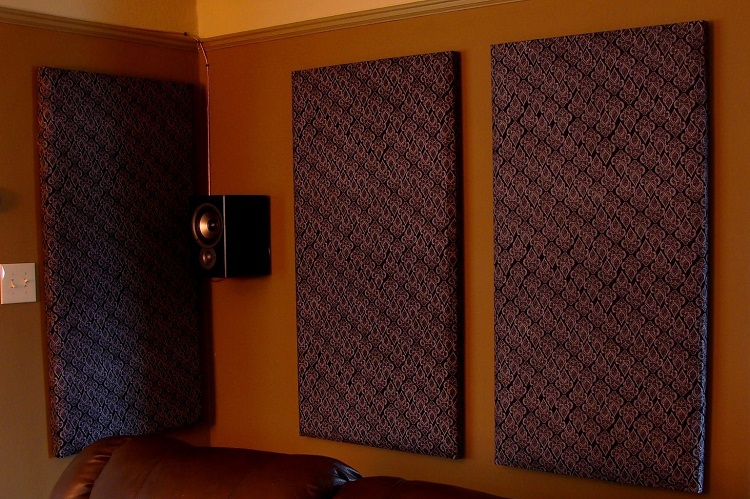Sounds are occurring all around us, at every moment of the day, and some of them are held more clearly than others.
If you’ve been trying to soundproof your home and block certain noises, you’ve likely looked into the marvel of sound absorbing materials and how they can help.
How does sound absorbing material work?
A material with sound absorbing properties is able to take the energy created from sound and turns it into another type of energy. These dense but soft materials help to absorb the sound or vibrations as the waves hit it, and it deforms this energy which reduces its effect.
To give you a better understanding of what sound absorbing materials do, we’ve created a simple guide that answers all of the questions you need to know. With a simple explanation of the science behind sound and absorption, you’ll be better equipped to choose a soundproofing material that works.
What Is Sound?
Without sound, there would be no need for sound absorption methods, so it’s a good idea to understand the science behind how it’s made and where it goes.
A sound wave is created by a vibration that is sent through the air at varying lengths, like when someone yells, and these can be categorized as either high or low-frequency sounds depending on their length.
A high-frequency sound wave can be reflected by thin materials, whereas low-frequency sound waves pass through them. Any soundwave that’s allowed to continue traveling will make noise unless there are materials or objects in the way.
When none of this sound is absorbed, it creates noise, and if your goal is to prevent this noise from occurring, you need the right materials and setup to absorb them completely.
What Is a Sound Absorbing Material?

A sound absorbing material is any type of material capable of absorbing these sound waves, and they come with a rating depending on effectively they do this.
The noise reduction coefficient or NRC is how much sound a certain thing can absorb, and if you’re trying to find the right fit for a room at home, it’s a helpful guide to have.
In the scope of sound absorbing materials, there are some proven to be better than others.
Their effectiveness all depends on how well they trap the soundwaves and dissipate or transform their energy, so there are varying degrees of absorption. These are some of the better choices on the market if you’re hoping to improve the acoustics of a room or home:
- Acoustic foam: This foam is usually made of materials like polyurethane and melamine. Rather than blocking sound, it helps it to pass through and creates better acoustics, and can be used for applications like speaker covers through to wall coverings when wrapped in an absorbent material.
- Acoustic panels: An acoustic panel is a simple device made of materials like fiberglass, open-cell foam, cellulose, and mineral wool. These adhesive panels can be stuck to the walls of a home to improve acoustics, or utilized as a standing board creating a sound barrier between two spaces.
- Acoustic fabric: These types of fabrics are ideal for absorbing sound and are commonly found in settings like cinemas and studios on the walls and ceiling, where acoustics need to be perfected. The dense material helps to reduce noise traveling but can also block out sunlight, so might also be used for household curtains.
- Acoustic coating: A specialized coating can be applied to the exterior of vehicles, machines, or even as underlay inside of a house. The most common material here is mass-loaded vinyl that feels like rubber but is denser and better at absorbing sound.
- Insulation batts: A sound insulation batt can be made of materials like rock wool, mineral wool, and fiberglass. These batts are commonly fitted inside of a home’s walls to prevent sound from traveling between rooms or might be found in settings like cinemas and professional studios.
- Floor underlay: A layer of material underneath the floor can absorb sound, with the best choices being cork, polymers, and felt. This is why it’s common for carpet and other types of flooring to have an underlay to prevent excess noise, although carpet on its own can still be effective.
- Architectural soundproofing: This includes any type of material used when building a house that improves its sound proofing or sound absorbing qualities. Common materials include sound proofing windows, acoustic caulk, and acoustic aluminum.
The Science Behind Sound Absorption
When a sound wave comes into contact with an object, it will either reflect off of it or be absorbed by it. If a sound wave is reflected, it will come back into the room, and if this reflection is powerful enough, it will create what people know as an echo.
With a sound absorbing material in place, the soundwaves are taken in by it, and then a small amount of it is transformed into another type of energy that reduces the noise it makes.
The thicker the material, the better it will do in this regard, as it’s able to lose more of the energy that came from the sound wave.
If you’re trying to achieve the perfect acoustics for a room, it’s usually found with a combination of reflection and absorption.
With too much absorption, the sound quality would be flat, but with too much reflection, it would be an echo. Therefore, getting the right balance is the key to achieving greatness in acoustical science.
Transforming Sound for Peace and Quiet

The method of sound absorption refers to transforming sound wave energy into another form of energy, but at its most simple, it’s a great way to improve the sound quality of your home.
With a better idea of the science behind absorption, you’ll know the best materials to achieve it, so it’s worth learning the basics.
Related Questions
Sound absorption is just one method of improving the acoustics of a room, and it’s incredibly easy to put into practice in your own home.
If you want to learn more about what you can do to make a room sound better or quieter, read on to see how we’ve answered these commonly asked questions.
What Household Items Absorb Sound?
There are lots of everyday items you can use to absorb sound without having to purchase any additional soundproofing materials.
Rugs and carpets, soft furniture, tapestries, wall art, curtains and blinds, and blankets can all be utilized in a room to reduce the amount of sound that escapes and help with acoustics.
Does Bubble Wrap Absorb Sound?
Bubble wrap is not an ideal material for absorbing sound because it lacks the mass that other denser materials have.
The air pockets on a sheet of bubble wrap may be effective at minimizing sound only slightly, but there are far better choices of household materials if sound absorption is your goal.
What Is the Best Carpet for Sound Absorption?
If choosing a carpet based solely on its sound absorbing qualities, wool is the best option, and preferably a cut-pile type.
Where possible, choose a wool carpet with a wool underlay, so that you absorb surface and verbal noise occurring in the room and improve the overall acoustics.
Resources
IntechOpen.com
www.AcousticalSurfaces.com
